Final report for ONE19-335
Project Information
This project aims to discover whether myco-phytoremediation restoration of riparian buffers can decrease phosphorus (P) loads entering surface water bodies while increasing native pollinator habitat. Myco-phytoremediation harnesses microbial, fungal and plant symbionts to mitigate soil pollution. In this study, three research plots were installed in a riparian area dominated by buckthorn. In one plot, buckthorn was kept in place. The other two plots were restored with a diverse polyculture of native vegetation; one of these plots was restored with mycorrhizae fungi. This research focused on whether a restoration with and without mycorrhizae would improve pollinator habitat diversity, reduce phosphorus in soil and soil water, and uptake P in above ground vegetation. Additionally, data was also gathered in a laboratory mesocosm experiment with a buckthorn treatment, and two restored treatments, mimicking the ones in the field. The field data revealed statistically significant increased plant species richness in the restored treatments vs the control treatments of buckthorn; there was a decrease of total phosphorus soil concentration in the mycorrhizally inoculated vs the uninoculated plots. Mesocosm data revealed statistically significant increased concentrations of Mehlich extracted P in the bulk vs rhizosphere across all treatments, statistically significant lower concentrations of Mehlich extracted P in the inoculated than uninoculated mesocosms, and statistically significant greater concentrations of P in the roots compared to above ground material. Gathering data on coppicing in the fall, before vegetation goes senescence, and continued monitoring are the next steps following this funded project date. Our data indicated that remediation is slowly happening yet according to previous studies tangible results will likely take at least a decade to become fully evident. Hence this pilot is becoming a long-term monitoring project. The farmer was pleased with the aesthetics of the sites and did inquire the total costs of our project with interest in perhaps extending the restoration techniques along the entire length of the buckthorn laden agricultural drainage system in the future. As long-term data sets are obtained and trends become more clear, these strategies have high potential to be adopted by farmers as innovative BMPs to decrease legacy P runoff through low cost green infrastructure systems. This will allow them to increase climate change resilience, diversify habitat, provide increased nutrient retention, and potential edible, medicinal, and craft-oriented products. The more than 30 farmers, conservation district managers, homesteaders, students, and land managers that attended our workshops or enjoyed onsite tours expressed great interest in applying similar strategies to neglected areas of land they tend. Other organizations that participated in applying these strategies include Vermont Youth Conservation Corps, several homeschool families, and more than 10 community members.
The purpose of this grant is to test informed hypotheses that mycorrhizal native riparian vegetation arranged in naturally occurring polycultures, replacing invasive species within and adjacent to agricultural drainage channels, can remediate legacy P in drainage discharge (measured as soluble reactive phosphorus, SRP) while increasing pollinator habitat.
Field Experiment Objectives
Phosphorus (P):
- Investigate whether the 3 treatments (control of original vegetation, native restoration plantings with and without mycorrhizae) within the riparian zone affect soil water SRP concentrations in the root zones (Figs. 1-7).Installation SF figures
Hypothesis: There is a difference in SRP concentrations among the following treatments: Original buckthorn dominated (OIV), Restored vegetation without mycorrhizae (RV), Restored vegetation with mycorrhizae (RVM). SRP concentrations vary in soil water in this order OIV>RV>RVM.
- Determine whether mycorrhizae result in increased P concentrations in willow plant tissue.
Hypothesis: P plant tissue concentrations will be greater in the restored area with mycorrhizae than the area without mycorrhizae
Habitat diversity:
- Determine plant community composition and plant species richness in the three plots.
This is to provide a baseline of the plant community composition for future research.
Mesocosm Experiment Objectives
Phosphorus (P):
- To measure the difference in soluble reactive phosphorus concentrations in soil water of each mesocosm treatment (inoculated willow, uninoculated willow, buckthorn).
Hypothesis: The SRP concentrations in soil water will follow this order: inoculated willow<uninoculated willow< buckthorn.
- To measure the difference in P plant concentrations and biomass between the three treatments.
Hypothesis: P concentrations in plants and biomass will be in this order: RVM>RV>OIV.
If these strategies succeed, farmers can replicate this model to decrease legacy P runoff through low cost green infrastructure systems, which increase climate change resilience, diversify habitat, provide increased nutrient retention, and edible, medicinal, biomass products.
Phosphorus pollution from agriculture is one of multiple water quality issues threatening freshwater health. In Vermont there are concerns about the agricultural impact on Lake Champlain’s health. As a limiting nutrient in freshwater ecosystems, excessive P causes algal blooms, which can involve toxic algae that threaten aquatic trophic health and impairs tourism through beach closures and stymied water-related activities. According to the EPA’s 2016 Phosphorus Total Maximum Daily Load (TMDL) agriculture accounts for an estimated 41% of base phosphorus loading for the Vermont portion of the Lake. Decades of P imports as animal feed and fertilizer have caused a buildup of excessive P concentrations in the watershed, referred to as legacy P (Roy, 2018). Lake Champlain received a D+ in its cleanup report card, stating there is limited data on agricultural practices’ ability to remove phosphorus pollution. (Weber, 2018) This project directly addresses this.
In a climate change adaptation survey (White, 2018), 74% of responding farmers demonstrated awareness of the problem, stating that they build soil health and use cover crops to manage heavy precipitation and flooding on their farms. The respondents emphasize holistic approaches, like regenerative agriculture, agroecology and permaculture (keyline, hugelkultur, berms, swales, and earthworks). This data indicates that farmers are open to alternative practices proposed in this pilot.
A survey of 21 VT farmers (18 certified or operationally organic) conducted by MycoEvolve (co-PI Rubin) indicates high farmer interest in mycoremediation. Seventeen of the 21 farmers (81%) are interested in mycoremediation strategies. Six would attend workshops at current pilot demonstration sites, 8 would attend public workshop highlighting research, 12 would consult fact sheets, 9 would take a class geared specifically to farmers, and 10 would access results in peer reviewed journal articles. However, concerns about implementing mycoremediation included: effect on climate change resiliency (5 respondents), cost (9), long term maintenance (11), potential hydrologic changes (3), displacing space geared towards productivity (6), and lack of knowledge about the topic (4). Both of these surveys indicate a need for improved management strategies. Before they can be recommended, data on them needs to confirm their efficacy. This is what we aim to provide.
Green storm-water infrastructure is now an accepted tool of urban pollution mitigation. This is not yet true for agriculture beyond basic Best Management Practices (BMPs) such as cover crops, installing buffers, and following nutrient recommendations. However, these BMPs do not effectively mitigate legacy P runoff from fields and drainage ways and can inadvertently cause legacy P transfers into the watershed (Sharpley et al., 2013). While these practices were designed to retain P within the landscapes to protect surface waters from agricultural P losses, they actually contribute P to surface water bodies This is particularly true concerning legacy P from past management practices because P cycles are closely linked to other macronutrient cycles which affect storage and remobilization of legacy in watersheds. Farm hydrological features such as gullies, soil macropores, bedrock fractures, tile drainages and artificial drainage tiles (the latter two which affect this site) serve as potential conduits for dissolved and particulate P. In these areas the P bypasses potential, can accumulate here, saturate all exposed sorption sites and convert these stores of legacy P into sources of P which enter downstream. Hence these areas in essence become “critical source areas” which are P hotspots of legacy P accumulation activated by continued overland flow; requiring more specific critical source design management and non traditional P remediation strategies. (Sharpley et al., 2013) This study focuses in particular on agricultural drainage ditches and riparian buffers in their role in this dynamic. In Ontario, Canada, the highest P trapping capacity was measured on buffers under native plants with a high percentage of vegetation cover ((Abu-Zreig et al., 2003; Hoffmann et al., 2009). A recent article noted: “to address water quality goals, there is a need to support development of innovative BMPs that provide multiple ecosystem and environmental benefits, while addressing both particulate and soluble nutrient losses (Duncan et al., 2019).” This is what we aim to do.
Incorporating fungi in mitigation of agricultural non-point pollution is not yet an accepted practice. This strategy involves incorporating arbuscular and ectomycorrhizae fungi which increase plant nutrient uptake efficiency ((Smith and Read, 2010; Jones and Oburger, 2011; Phillips, 2017). Inoculating plantings on field and drainage way edges may help mitigate legacy P. Additionally coppicing plants that have uptaken the P will physically remove it from the area so that it does not reenter the soil and waterway when vegetation becomes senescent. Harvesting of grasses and trees on buffer zones removes accumulated P and reduces P saturation, increasing P retention on buffers and decreasing dissolve reactive P (DRP) losses in surface runoff ((Lee et al., 2000). For this reason, harvesting of buffer zones is strongly recommended in agri-environmental practices (Hoffmann et al., 2009).
At Shelburne farms total P concentrations in drainage water is 10 to 100 times greater than recommended P concentrations for that section of the lake (Dana Bishop, unpublished data). This is in- spite of sustainable farm practices. It is challenging to predict P retention in buffers in general and at this site in particular due to complex hydrological processes (tile drain networks, continued inundations uphill, a neighboring uphill site of legacy P, and discharging ground water) at the site. The effectiveness of riparian buffers in retaining P is directly related to the form of P entering, mechanism of retention and biogeochemical conditions (Hoffmann et al., 2009). There are many physical and biochemical variables affecting P retention in buffers such as soil type, (sorbents, redox state, pH), degree of P saturation, buffer width slope, vegetation type & management, source area, ratio of buffer area to source area, sediment composition, and P speciation, oxidants and reductants present, pH, water flux, biological activity, (Hoffmann et al., 2009) and vegetation. Although P may be efficiently retained in buffer zones, remobilization of DRP has also been reported ((Dillaha, 1989; Uusi-Kämppä, 2005). Desorption of P from the buffer zone depends on the degree of P saturation, and in the long-term buffer zones may be saturated with P and ultimately become a source of P ((Dillaha, 1989; Uusi-Kämppä, 2005). At this site of Covington Clay it is particularly challenging to predict long term retention because on soils with a higher clay content, there is lower retention by sedimentation of smaller P-enriched clay colloids, less infiltration of water in low-permeable clay matrixes, or a balancing of retained P with newly mobilized colloidal or dissolved P (Dillaha, 1989).
Additionally bacteria, fungi and plants incorporating phosphate into their biomass help regulate the transformation of P between organic and inorganic pools of P. However decomposition and mineralization return inorganic P to the soil solution or surface waters (Hoffmann et al., 2009). Hence microbial and plant uptake are considered short-term transient P pools which can only contribute considerably to P removal when they are harvested (range of 4-15 kg P ha/yr) (Hoffmann et al., 2009).
Legacy P is suspected as a source of the high levels of P due to the site history involving intensive clearing, heavy grazing, superphosphate fertilizer application (Donnis, Erica Huyler, 2000), and continued inundations from a current compost pile on top of a hill that flows into swales leading into our project site. Our project modifies buffers around a drainage way with restored native species, half of which are mycorrhizally inoculated.
Storm-water designers, environmental managers and policy makers have also expressed interest in mycoremediation. For example, the town of Colchester hired Mycoevolve, a company specializing in ecological resilience and watershed restoration harnessing fungi and plants, to treat storm water in a tributary to Lake Champlain. Since completion of the project other private sector and community stakeholders have contacted MycoEvolve with interest in strategies to mitigate P runoff and enhance pollinator habitat.
Cooperators
Research
Site Characterization and Preparation
Field
Preliminary soil samples were collected to characterize pH, fertility and total P concentrations in soils. Preliminary soil and native tree root samples were gathered to determine original mycorrhizae (arbuscular (AMF) and ectomycorrhizae (ECM)) presence in the three experimental plots. Our root sample microscopy studies from pre-installation samples indicated there was no ECM present before installation. Therefore, our qualitative studies on mycorrhizae will focus on AMF. Initial soil investigation of the AMF in the three plots indicated that there actually were mycorrhizae present in the control plots. Further research revealed that this buckthorn species (Rhamnus cathartica) does indeed have selective mycorrhizal partners. This is a critical finding as our assumption was that there were no mycorrhizae present. We preceded with the study, as designed, and kept this new inventory as the baseline for mycorrhizal populations.
Site preparation involved removal of invasive plants of buckthorn from February through May 2020. We collaborated with Shelburne Farms staff in this effort who chain sawed all buckthorn at hip height mid winter. Our team then physically removed all of the brush into piles to be chipped and then using hand tools removed all buckhorn root masses and bodies that were located > than 2 ft from the drainage way. All nonnative species closer to drainageway banks were left as stumps and any regrowth were cut back repeatedly throughout the season. This technique (Mike Bald of Got Weeds, personal correspondence) creates a 90% death rate without chemicals, mechanical equipment or soil microbial community disturbance.
Meanwhile polyculture plantings and installation designs were drafted by Jess Rubin, ordered and purchased from VT Wetland Plants. Low-P perennial mix from VT compost was steam pasteurized and left to equilibrate for 6 weeks. All purchased native plants were potted up in this compost soil; half with Mycorrhizal Applications’ EndoEcto mix blended into the mix. Plants remained in pots for 2 months for acclimatization.
A 12-foot deer fence was erected around both experimental plots with corresponding latched doors to enter an exit. The control plot of nonnative buckthorn between the two experimental plots was not surrounded by a fence.
Six piezometer holes were dug in early spring (outside of) on either side of the channel adjacent to the treatment areas (RV, OIV, RVM). Using an auger, I dug down 20 inches past where redox features appeared (approximate depth to seasonal high water table). I left the holes for a week to observe base flow water entering these holes. I then measured the depth to water from the top of the hole. Each auger hole was surveyed against a common elevation datum. Ground water elevation in the auger holes was calculated as the elevation of the auger hole minus the depth to ground water at that point. Triangulation was used to find the ground water elevation surface and ground water flow direction. We found that the base flow of the water was from the NE to the SW, hydrologically traveling from the uphill composting area and legacy P laden field to the agricultural drainage ditch through our study site into the lake.
Mesocosms
Installation
At the end of May 2020, once all plots were prepared and plants acclimatized outside in pots, Vermont Youth Conservation Corps (VYCC) accompanied us and community volunteers in raking the soil in the experimental plots, seeding both restoration plots with a native riparian seed mix (RVM plot had inoculated seed), laid down jute erosion control mat and following the planting map Jess Rubin designed, planted all native species, inoculated and uninoculated according to their assigned plot. Everything was watered in and consistently watered with the help of Shelburne Farms’ water truck throughout the summer and fall in between rain events, that were less than 1 inch over 24 hours.
Data Gathering Post installation
Field Experiment
Objective 1: investigating whether the 3 treatments within the riparian zone affected soil water Soluble Reactive Phosphorus (SRP) concentrations in root zones. After each storm event that delivered > .5 inches of rainfall, we collected soil water from 6 suction cup lysimeters in each treatment placed randomly in the root zones near willow stems at restored sites and near buckthorn sapling roots of similar size in the plot with the original invasive vegetation. Each sample was filtered through .45 um syringe filters prior to analysis. The samples were then stored frozen until analyzed for SRP by the Agricultural Environmental Testing Lab at UVM (AETL).
Objective 2: determining whether mycorrhizae increase P concentrations in willow plant tissue. To measure P concentration in willow leaves, 12 leaves per willow (total of 48 leaves) were gathered from the RV and RVM plots mid and late summer (July & August). Leaves were dried at 60 C, ground and then analyzed via the AETL for P concentration in leaves. Additionally, willows were coppiced in February of 2021, dried, ground up and submitted to AETL to determine how much P accumulated and was stored in the branches.
Objective 3: determining plant species richness and plant diversity in the three plots. All of this data was gathered once a month starting in July 2020, after planting had 6 weeks to acclimatize to the site, through July 2021.
To determine plant species richness, I set up four transects parallel to the waterway which were placed at random distances from the water way. All species along each transect were then recorded. Richness was determined as the number of species present and recorded as the compilation of all the different species found along the transects.
To capture plant diversity, I set up five quadrats per plot (0.5 m by 0.5 m quadrat). These were randomly located in each plot. Species in each quadrat were identified and their abundance recorded and analyzed with the Shannon-Weaver Diversity Index.
Mesocosm Experiment
Field plants were repotted in 6.5-cm diameter, 20-cm long conetainers in pasteurized low-P compost mix which had acclimatized for 6 weeks. There were three treatments: Pussy willows (Salix discolor) were planted in 5 mesocosms inoculated with mycorrhizae, and 5 mesocosms that were not inoculated. Five more mesocosms were planted with buckthorn saplings harvested from the control plot that were similar in size to the pussy willows; the medium in these pots were also not inoculated. The total soil volume in the conetainers was approximately 800 mL and pore volume were estimated as 400 mL (50% porosity).
Objective 1: Determining the difference in SRP concentrations in soil water of each mesocosm treatment (inoculated willow, uninoculated willow, buckthorn). Twice a week 14 mg/L of SRP was added to the mesocosms via fertigation. The effect of plant treatments on soil water SRP was measured by leaching events induced every week or two over an eleven-week period. Amount of water added to and leaving each mesocosm as well as leachate color was recorded. All outflow was filtered through .45 um syringe filters. The samples were stored on ice and frozen until analyzed for SRP by the AETL.
Objective 2: measuring the difference in P plant concentrations and biomass between the three treatments in mesocosm experiments.
To assess whether the mycorrhizae-plant association results in increased plant uptake of P, entire plants were sampled at the end of the experiment in March 2021. The plants were harvested and dried separately for stems, roots and leaves. Each sample was dried in paper bags at 60 C. After drying, each sample was ground into a powder and analyzed for P concentration by the AETL.
Our field experiment data on mycorrhizal counts, pH, TP, SRP, P leaf, P branches, plant diversity and richness revealed that a long-term monitoring was needed to obtain results that could inform BMPs. We obtained additional funding, that allows us to begin year 3 of long-term monitoring to help us gain clarity on trends that were clear but not yet statistically significant. This is likely because: a. it is impossible to remediate 400 years of colonial agriculture and legacy P in two years, b. the literature reveals it takes at least a decade or more for tangible effects to appear from remediation strategies (Meals et al., 2010; Hamilton, 2012) and c. because there were many covariant factors (shade, presence of mycorrhizae in control plot, drainage tiles flowing into our sites, saturated P soil conditions) affecting the data. Hence no conclusive patterns appeared. However, a few statistically significant trends were found in both our field and laboratory studies which indicate that this research is worth continuing to pursue. While we have extensive data sets from both years from May through end of the project window, we chose to focus on comparing July of year 1 to year 2 as a snapshot. This is the data which we will share and discuss below.
Results for Field Study by Objective
For Objective 1, (Investigate whether the 3 treatments: (control of original vegetation (OIV), native restoration plantings with (RVM), and without mycorrhizae (RV),) within the riparian zone affect soil water SRP concentrations in the root zone (Figs. 1-7). Installation SF figures). We found that SRP in buffer soil, was lower in restored mycorrhizal treatments while the control had the highest (Figure 8A in attached document). While this is not statistically significant, it is in line with our original hypothesis that: SRP concentrations vary in soil water in this order OIV>RV>RVM.
In terms of spring storm data there was no statistically significant differences among treatments. However, the restored mycorrhizal plot had the lowest concentration of SRP in storm water compared to the control and uninoculated restored treatments (Figure 9 in the attached document). In terms of fall storm data there is also no statistically significant difference among treatments but trends indicate that the restored mycorrhizal treatment had the highest concentration of SRP while the control has the least (Figure 10 in attached document). This may be due to P released from fungi, bacteria and plants during the fall senescence. While field conditions of continued upland inundations, tile drain outlets, and occasionally overland flow into the riparian zone may complicate our ability to find significant trends in this data, more seasons of data will clarify distinctions among treatments.
We found that TP in the inoculated plot was statistically significant lower in the restored mycorrhizal than restored uninoculated plots (p=.0407) (Figure 8B in attached document). This is consistent with our findings on SRP in soil water (Figure 8A).
For Objective 2 (Determine whether mycorrhizae result in increased P concentrations in willow above ground plant tissue) we found that the willow leaves and stem material from the uninoculated treatment had more P concentrations than the inoculated willow leaves (Figures 11 & 12 in attached document). This is not what we expected. It is possible that the greater TP concentrations (Figure 8B) found in the uninoculated plot resulted in greater P uptake in this plot. However, coppicing in late winter (while in line with pruning practices creating least stress for the trees) may not capture P taken up during the growing season because in late fall P is translocated to the roots. Hence we coppiced the willows again in early September 2021 (passed this project’s window) to gain greater clarity on this. We also gathered more leaves in August 2021 (also passed this project’s window) to continue to track trends.
For objective 3 (determining plant species richness and plant diversity in the three plots) we found that the control had statistically significant lower richness than both restored plots (p<.0001) in both years (Figure 13 in attached document). This is not surprising since we replaced a low diversity monoculture of nonnative species with native polycultures. The statistically significant differences were: that the uninoculated had greater diversity than the inoculated plots (p=.0139). This indicates that restoring nonnative species with riparian native species increases pollinator habitat.. However more importantly, the numbers did not decrease significantly between years, indicating good success. It is worth noting that these restored plots did require monthly maintenance throughout the growing season; cutting back regrowth on some nonnative stumps and manually removing a few seedlings and opportunistic species from each restored plot such as poison ivy, thistle, staghorn sumac, and burdock. This baseline of plant community composition lays the foundation for long-term research into succession in restored ecosystems as well as for more in depth study of pollinator habitat. We are particularly curious about how the inoculated and uninoculated restored plots will diverge under succession over the years.
To check our assumption on mycorrhizal communities in all three treatments, we counted mycorrhizal populations in bulk soil before installation and then in July both years. ANOVA indicated statistically significant differences among treatments (p=.0021). Tukey HSD identified statistically significant lower counts of mycorrhizae in uninoculated restored plot compared to the control (p=.0023) & restored mycorrhizal plot (p=.0149) (Figure 14 in attached document). This data indicates that a. the mycorrhizal treatment worked b. the mycorrhizal partners of buckthorn in the control plot are present. Their role remains a living question to us.
Results for Mesocosm Study by Objective
For objective 1, we are not reporting our findings due to unanticipated preferential flow, confounding our data.
For our objective 2 (to look at the difference in P plant concentrations and biomass among the treatments), our data demonstrated statistically significant trends across all three treatments. The majority of P that was uptaken in the plant when we harvested them in March was located in the roots rather than the stalk (for OIV p =.0003) (for RV p =.0055) (for RVM p =.0018) (Figure 15 in attached document). This confirms our suspicion that late winter coppicing does not effectively capture plant P. Contrary to our hypothesis, there was no significant difference in plant P among treatments. It seems from findings in Figure 15 that the P perhaps is being stored in the roots of the plants starting in the fall after senescence. This has informed our new strategy of coppicing in the late summer-early fall is more likely to catch P in above ground plant biomass.
We found that P concentrations were greater in the bulk soil than the rhizosphere soil (P< 0.0001) in all treatments (Figure 16 in attached document). Based on this finding, we redesigned our lysimeter placing to be further from the willow stem in spring of year 2 to capture more of the mycorrhizal activity in the bulk soil. More importantly, though, Mehlich extracted P was lower in the mesocosms that were inoculated with mycorrhizae than those that were not (p=.033). These results suggest that mycorrhizal activity in the bulk soil facilitating P uptake is an important process for capturing P from the buffer.Figures and Tables for final report SARE ONE19335
We investigated if ecological restoration efforts replacing nonnative buckthorn stands with native riparian polycultures could facilitate phosphorus interception, particularly when inoculated with mycorrhizae fungi, while increasing pollinator habitat in previously neglected riparian areas on farms. This research operates according to the model of equilibrium chemistry in which total phosphorus and soluble reactive phosphorus are in equilibrium. When plants uptake P via mycorrhizal facilitation, the SRP concentrations are reduced. This in turn causes the TP pools to release P into solution, thereby slowly decreasing overall legacy P. Data from the first two years of this study show that there is a lower SRP to TP ratio for the restored plots compared to the control plots. This suggests there is some effect in restoration.
Early data shows that plant diversity in the restoration plots has not diminished from year 1 to year 2. This suggests that the pollinator habitat created through our restoration efforts has been successful in this time scale. Continued monitoring is needed to assess the long-term sustainability of the restoration techniques. So far it seems that manually replacing buckthorn stands with inoculated native riparian polycultures and cyclically coppicing them may mitigate legacy P while diversifying habitat on the farm. At this point the only statistically significant difference between data collected from the two restoration plots is increased plant diversity in the uninoculated plot. Given that the plant community in the uninoculated plot is as diverse or more diverse than the plant community in the inoculated plot and that there are no significant differences between the two strategies in P mitigation, we wonder whether mycorrhizal inoculation in necessary. However. we expect that mycorrhizal efficiency may increase with succession and thereby increase P mitigation over time. We plan to continue monitoring the site for both succession of the plant community and P mitigation since previous studies indicate that long term monitoring is needed to understand the effect of mycorrhizae on succession and thus provide more conclusive results. Should our restoration prove successful in the long-term, our strategies may be adapted as innovative BMPs to further the goals of protecting water quality and ecosystem resilience.
Education & Outreach Activities and Participation Summary
Several educational photos were taken throughout the spring, summer and fall highlighting the project and different aspects of it. These were posted on instagram and facebook with informative descriptions.
Participation Summary:
Shelburne Farms participated by providing site preparation (cutting buckthorn trunks) in late winter-early spring and in helping with watering assistance throughout the summer and fall. Participation by local groups was discouraged by the University due to Covid-19 crisis and in agreement with Vermont Governor’s orders. MycoEvolve hosted a series (13) of physically distant work parties over late winter and early spring to assist in site preparation of the Shelburne Farms project site.
In July 2021 Jess Rubin of MycoEvolve, Dr. Josef Gorres of UVM, Dana Bishop of Shelburne Farms and Mike Bald of Got Weeds, (who mentored her in nonchemical nonnative species removal) hosted a public on-site workshop at Shelburne Farms which 18 participants attended including: farmers, homesteaders, conservation commission members, funders, land managers, and farmer interns. The handout included here was shared with the attendees, myco-riparianbuffers-workshophandout-july2021_final
An article on the workshop was written up in the Agriview November 2021 edition from one of the participants in that workshop.
Additionally the following day Jess Rubin offered a similar onsite workshop for 15 students in UVM’s Soil Fertility and Management class with two additional farmers and a naturalist educator joining as well.
August/September 2019: Site Analysis: Jess Rubin walked site with UVM Extension consultant, Dana Bishop Farmer, and Water Resource Manager Consultant Lauren, and soil scientist Josef Gorres. Coordinate with Shelburne Farms on the final research and landscape design. Secured project with VYCC and walked site with Justin Geibel. Output: Drafted design outline and created series of maps: site map, contours, hydrology, installation plan.
October/November 2019: Ground truthed P concentration distributions throughout the site, through a soil morphology soil pit study and initial water and soil samples in existing drainage way and throughout site. Conducted soil morphology and hydrological analysis. Output: identified SRP and TP hotspot for installation location. Created an initial site analysis report with recommendations and site limitations. Designed research begins.
November/December 2019: Coordinate with Shelburne Farms and VYCC installation details, spring/summer schedule. Began intern search. Began plant palette and mycorrhizae species orders. Located companies to order plants, mycorrhizae and erosion materials from. Output: solid plan for spring summer installation. Planting sketch and initial palette. Rough draft of methodology data tables created.
January- April 2020: Shelburne Farms Staff chainsawed the trunks off all buckthorn species in the restoration plots. Jess Rubin via MycoEvolve (since UVM research was shut down to COVID) organized 12 physically distant work parties in which 11 community members and two homeschool families helped remove the trunks and limbs into piles to be chipped and then removed roots of all buckthorn species in the restoration sites more than 2 ft from the waterways. Some of these community members also helped to erect the deer fence and construct the doors.
March 2020: polyculture planting designs were completed. Plants were ordered from VT Wetland Supply. Low P perennial soil mix was pasteurized and brought to sit at the UVM Horticulture Farm. Jess offered an educational workshop 3 days before COVID broke out in Vermont at Fletcher Free Library in Burlington sharing with the local community about this project. Article in '7Days' came out which highlighted the project.
Vermonters Face Stormwater Threat With Fungi, Rain Gardens and More _ Climate Crisis _ Seven Days _ Vermont's Independent Voice
April 2020: half of pasteurized soil mix was inoculated with Mycorrhizal Applications Endo/Ecto mix and the other half were kept uninoculated. Bare roots plants from VT Wetland Supply were repotted in their corresponding treatment soil types for both field and mesocosm experiments.
May 2020: Jess and an intern gathered soil and native tree roots samples for pH, soil Total P concentrations and to evaluate mycorrhizal presence pre-installation in treatment plots. All soil and roots for mycorrhizal analysis were placed them in the fridge to be analyzed over December 2020 break via microscopy. In late May VYCC and community volunteers assisted with installation and watering. A short video was created by Red Fox Media that circulated facebook.
June-November 2020: treatment plots (1760 ft2 of the two treatment areas) were watered provided by Shelburne Farms’ water truck in between adequately sized storms (>1inch over 24 hr period) with 510 gallons once a week. This calculation is based on the maximum evaporation rate of 1 inch with .5 crop coefficient. Field data of monthly pH tests, plant species richness and diversity data, storm based lysimeter testing, and two P leaf tissue sampling were gathered. During this time mesocosm experiments were also conducted. Jess shared information about this project with Dr. Eric Roy’s Bionutrient lab via a zoom presentation. An article for the International Journal of Environmental Research and Public Health was written by Jess Rubin with assistance from advisor Josef Görres during this time.
August 2020: Abenaki members of the Alnobaiwi, a 5013C dedicated to preserving Abenaki cultural heritage conducted a ceremony at the restoration research site with clan mothers. 12 community members (several of who helped in site preparation) attended the event. Six individual tours were offered to individuals who expressed interest in the project. Interview with DC Extinction rebellion covered the project when interviewing Jess Rubin about restoration work with which she is involved through a you tube video.
September 2020: a group of students from a UVM introductory class in environmental science were given a tour of the project. They gathered data to use for their class project through which they learned the basics about mycoremediation and data analysis.
December 2020: The journal article, Potential for Mycorrhizae-Assisted Phytoremediation of Phosphorus for Improved Water Quality, was accepted after a few rounds of edits by the IJERP and published on 12/20. All 2020 data is being analyzed via JUMP software over school vacation. Mycorrhizal presence is also being quantified during this time via microscopy. 2020 final report is written and submitted. New SARE partnership grant was written to continue the research beyond a year.
Photo Gallery:
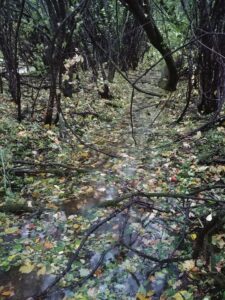
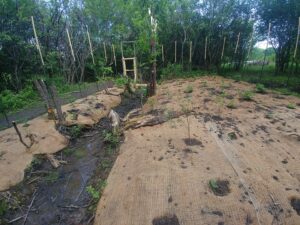
planting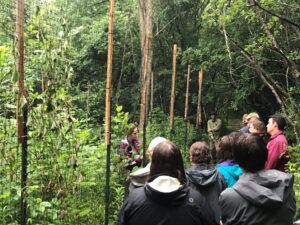
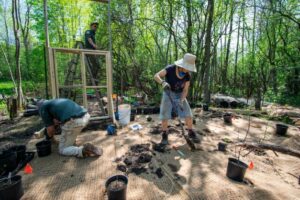
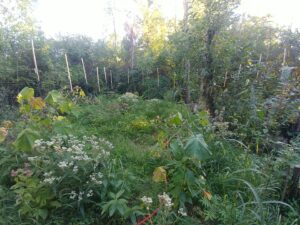
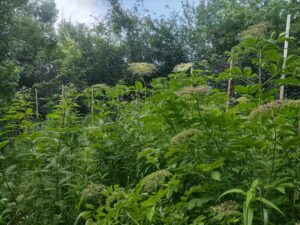
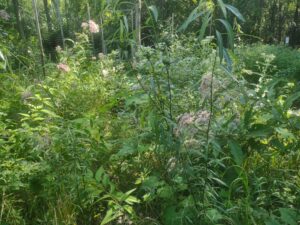
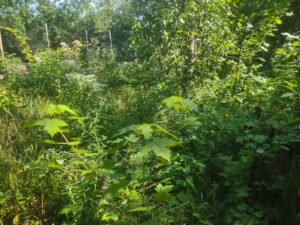
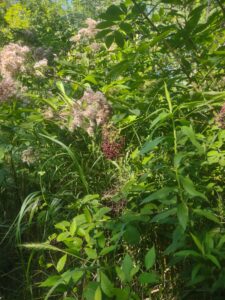
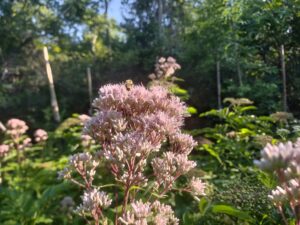
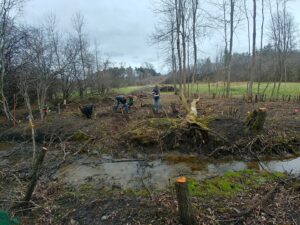
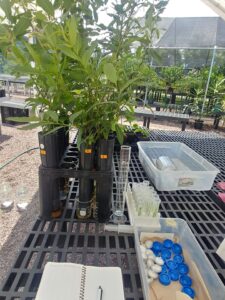
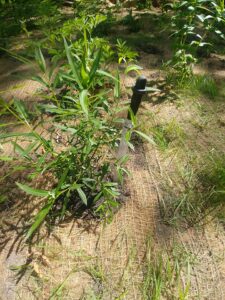
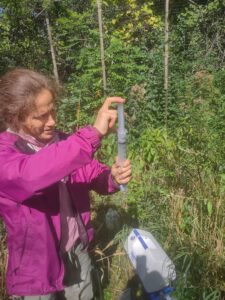
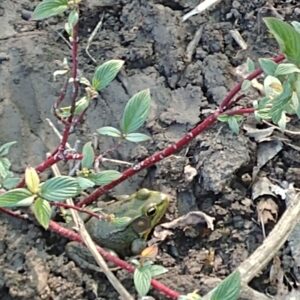
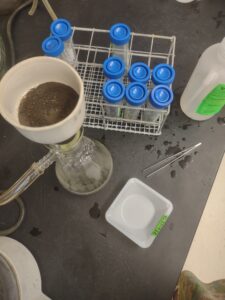
Learning Outcomes
The following is more about what we learned. We are still waiting for more data before we can share something tangible to farmers.
Our 2020 field season revealed a few patterns.
In terms of soil, there was no significant difference in soil pH between the plots. The pH values varied between 3.13 –6.28. The average pH was 4.82 However over time the soil pH decreased by an average of 1.20 pH units in all plots. This may be due to seasonal biogeochemical changes.
In terms of soluble reactive phosphorus (SRP) concentrations in sol water, the variations within treatments is less than the variations between the treatments suggesting a real treatment effect. There was a significant difference in the SRP between the inoculated and uninoculated plots; the mean SRP of the inoculated plot was greater than of the uninoculated plot. This is opposite of what we expected and may be due to various field variables we are still in the process of understanding such as differing levels of shade, and P inputs from uplands. or greater differences in legacy P
In terms of P concentrations in the willows in the two restoration plots, data from two separate samplings indicated the leaves in the inoculated plots had smaller concentrations of P than the uninoculated plots. This is opposite of what we expected and may be due to various field variables we are still in the process of understanding, including the potential that stores of P in the roots have not been evaluated,different inputs of P from uplands. and legacy P. Over time from early summer to mid autumn in both plots the leaf P-leaf concentrations increased.
We hope the second field season in 2021 will shed more light on the processes in the plots. We are planning to investigate soil nutrient content in the plots to evaluate any difference in soil fertility that could explain the unexpected effect of treatments on P concentrations in soil water and leaves.
In terms of our mesocosm studies, the overall trend was that leachate from the buckthorn had the least SRP while the inoculated had the most SRP. This may be due to the fact that the buckthorn may have still had its AMF partners in its roots while the restored willows either did not in case of the uninoculated or were just being established in terms of the inoculated conetainer. Over time the SRP concentrations seemed to decrease until the end of the early fall when the concentrations started to rise. This may be due to the seedlings growth beginning to take up P and then releasing it once they began entering senescence.
In the second year, we will make slight changes to the mesocosm experiment. For example we will seal the soil around the edges of the mesocosms to prevent leachate from finding macropores along the conetainer walls bypassing the soil. We hope the second lab season in 2021 and our improved methodology will shed more light on the processes in the mesocosms.
Project Outcomes
Dana Bishop the farm manager of our partner farm, Shelburne Farms, shared that she was impressed with the aesthetics of the restored sites and inquired how much the whole process costs. She expressed future interest in our extending the restoration up along the entire drainage ditch currently dominated by Buckthorn.
Additionally, we designed a vegetative treatment system for Dana Bishop to offer more direct remediation to the field just below the compost pile. This report not only included a literature review, to scale designs, a plant palette and realistic budget but it also quantified the amount of P that could be remediated through this installation with our current treatments below in place. The farmer appreciated our effort and the information but felt it was too much to implement at this time. Joshua Faulkner of UVM Cooperative Extension, who was the professor overseeing the report that was written, presented, and delivered to the farmer offered positive feedback saying that it was “I truly think you have produced something that will be valuable to your Community Partner, and will be fully considered as they discuss the farm’s water quality impact.”
Another local farmer who came to our workshop, hired graduate student and MycoEvolve owner Jess Rubin to offer a consultation on alternative practices for farming considering the hydrology of her farm which was bordered on both sides by a wetland.
At one of the workshops, farming interns at the Intervale were impressed that nonnative species could be successfully removed and replaced by native species using only hand tools and community muscle. Seeing our restoration buffers in person and the unaltered buckthorn stands nearby changed their previous understanding that chemicals and machines were needed to restore ecosystems. They asked at the workshop to confirm this new understanding if it was possible to restore other ecosystems using these techniques and the answer that both Mike Bald and Jess Rubin gave were “yes!”This project also informed a new partnership proposal on using field buffers and margins as mycorrhizal banks that may improve phosphorus utilization by crops. Farmers at the Intervale whose fields have high soil P levels are concerned that their practices are contributing P to the adjacent Winooski River expressed interest in our research. In the past 2.5 years we have been in conversation with them about ceasing applications of local chicken manure and following a nutrient management plan that considers the role of P in water pollution. Given our preliminary results they are now ready to incorporate mycorrhizae research involving mycorrhizal buffers for the edges of their fields.
Josef Gorres and Jess Rubin published the following paper: Citation: Rubin, J.A.; Görres, J.H. Potential for Mycorrhizae-Assisted Phytoremediation of Phosphorus for Improved Water Quality. Int. J. Environ. Res. Public Health 2021, 18, 7. https://dx.doi.org/doi:10.3390/ ijerph18010007 https://www.mdpi.com/1660-4601/18/1/7
The literature review in this paper was the foundation for this research. Publishing in a peer reviewed journal allowed us to highlight the research gaps in the field we aim to fill and to allow farmers, scientists, land managers, riparian buffer practitioners…to learn about the importance of mycorrhizae in agricultural practices.
This March 2020 article “Vermonters Face Stormwater Threat With Fungi, Rain Gardens and More “ in Burlington’s Seven Days Newspaper, allowed our community to learn about this research in a way that which translates some of the complex science into more accessible language.
In November 2021 Agriview will be publishing an article “Ongoing Myco-Phytoremediation Research at Shelburne Farms” based on the workshop we gave this summer. While it simplifies the research tremendously, it highlights the key points and will provide more education to the agricultural community.
Looking back, our study’s approach and methods were both successful and challenging. What was successful was that our design, nonnative species removal strategy, installation, data gathering, maintenance, and monitoring protocols worked well. What was challenging was that there were covariants in our field pilot such as shade, previous native species & mycorrhizal presence, hidden tile drainage outlets and variable legacy P conditions. On farm research makes it difficult to control all these variables. Our mesocosm lab studies helped us hone in on particular phosphorus cycling processes that linked plant, mycorrhizae and water quality. There were unanticipated challenges concerning preferential flow that made it difficult to gather data on P leaching. However, plant and soil P concentrations at the end of the mesocosm incubation yielded important information that informed our field data interpretation and the design of a second mesocosm experiment we are analyzing now. In addition, the mesocosm experiment also raised questions with respect to low and high soil P concentrations that we are answering in the second mesocosm experiment. We also incorporated another shrub of Red Osier Dogwood (Cornus sericea) into this new experiment to compare the P uptake efficiency of two shrub species. Based on the first year mesocosm experiment and field data, we made adjustments to our sampling methodology This included a. moving our lysimeters further away from the willow and buckthorn stems since the experiment indicated that the statistically significant mycorrhizally mediated P uptake occurred in the bulk soil rather than the rhizosphere, b. Moving our coppicing practice to late summer in year 2 rather than late winter to maximize removal of phosphorus, c. Adding Shagbark Hickory (Carya ovata) to our restoration plots where gaps were left by a few dead plants after year 1.
The data collected for this research will be published in an article for the peer reviewed Journal of Restoration Ecology and will be Chapter 2 of Jess Rubin’s thesis. Data from Mesocosm 2 will be published in a peer reviewed Journal of the New Phytologist and will be Chapter 3 of the thesis. Findings from this robust greenhouse investigation will inform our upcoming mycorrhizal bank experiment at the Intervale. The farm site for this new experiment was selected because the hydrology is much less complicated. We will continue our soil water and plant sampling at Shelburne through new grants we have already obtained.
There are many areas which we are investigating because they require further study. These include: mycorrhizal efficacy in low vs high P soils, mycorrhizal succession and its affect on plant succession and seed bank recovery after a site is restored. Mike Bald of Got Weeds recently wrote “The collaborations were impressive. You don’t see that much overlap often. And the work is foundational. There is so much more to explore; namely, the impact on seed banks. I’ve learned that year 3 is critical year for transitioning sites so this project takes us right to that key gateway.”
Legacy P and its threats to fresh water quality is a problem not only throughout Vermont but throughout the world wherever industrial agriculture has dominated the landscape. For this reason we have expanded our educational outreach in creative ways such as: signage outside of our greenhouse mesocosm experiment and at the Shelburne Farms research site, through Instagram, facebook, the MycoEvolve website, upcoming workshops this fall and winter, a survey shared with local riparian buffer practitioners, and attending various bioregional webinars concerning water quality, green infrastructure, agriculture, and riparian buffers.
Knowledge of our results would most benefit Extension staff, farmers, landowners, gardeners, property owners, riparian practitioners, conservation commission members, and state agencies that offer services for and advise on improving water quality and pollinator habitat. This is because strategies which we investigate can be applied across various terrestrial contexts to protect water quality and grow pollinator habitat.
Citations
Abu-Zreig, M., Rudra, R.P., Whiteley, H.R., Lalonde, M.N., Kaushik, N.K., 2003. Phosphorus Removal in Vegetated Filter Strips. J. ENVIRON. QUAL. 32, 7.
Dillaha, T., Reneau R.B.,. Mostaghimi S.&. Lee D., 1989. Vegetative filter strips for agricultural nonpoint source pollution control. Transactions of the ASAE 32, 513–51.
Donnis, Erica Huyler, 2000. The History of Shellburne Farms; A Changing Landscape, an Evolving Vision. The Vermont Historical Society, Shelburne, VT.
Duncan, E.W., Osmond, D.L., Shober, A.L., Starr, L., Tomlinson, P., Kovar, J.L., Moorman, T.B., Peterson, H.M., Fiorellino, N.M., Reid, K., 2019. Phosphorus and Soil Health Management Practices. Agricultural & Environmental Letters 4, 190014. doi:10.2134/ael2019.04.0014
Hamilton, S.K., 2012. Biogeochemical time lags may delay responses of streams to ecological restoration. Freshwater Biology 57, 43–57. doi:10.1111/j.1365-2427.2011.02685.x
Hoffmann, C.C., Kjaergaard, C., Uusi‐Kämppä, J., Hansen, H.C.B., Kronvang, B., 2009. Phosphorus Retention in Riparian Buffers: Review of Their Efficiency. Journal of Environmental Quality 38, 1942–1955. doi:10.2134/jeq2008.0087
Jones, D.L., Oburger, E., 2011. Solubilization of Phosphorus by Soil Microorganisms, in: Bünemann, E., Oberson, A., Frossard, E. (Eds.), Phosphorus in Action, Soil Biology. Springer Berlin Heidelberg, Berlin, Heidelberg, pp. 169–198. doi:10.1007/978-3-642-15271-9_7
Lee, K. et al., 2000. Multispecies Riparian Buffers Trap Sediment and Nutrients during Rainfall Simulations. Environmental Quality 29, 1200–1205.
Meals, D.W. et al., 2010. Lag Time in Water Quality Response to Best Management Practices: A Review. Journal of Environment Quality 39, 85–96.
Phillips, M., 2017. Mycorrhizal Planet: How Symbiotic Fungi Work with Roots to Support Plant Health and Build Soil Fertility. Chelsea Green Publishing.
Sharpley, A., Jarvie, H.P., Buda, A., May, L., Spears, B., Kleinman, P., 2013. Phosphorus Legacy: Overcoming the Effects of Past Management Practices to Mitigate Future Water Quality Impairment. Journal of Environmental Quality 42, 1308–1326. doi:10.2134/jeq2013.03.0098
Smith, S.E., Read, D.J., 2010. Mycorrhizal Symbiosis. Academic Press.
Uusi-Kämppä, J., 2005. Phosphorus purification in buffer zones in cold climates. Ecological Engineering, Riparian buffer zones in agricultural watersheds 24, 491–502. doi:10.1016/j.ecoleng.2005.01.013
Information Products
- Potential for Mycorrhizae-Assisted Phytoremediation of Phosphorus for Improved Water Quality (Peer-reviewed Journal Article)
- Multi-functional Riparian Buffers for Myco-Phytoremediation of Phosphorus and Pollinator Habitat (Conference/Presentation Material)
- The effects of mycorrhizae on phosphorus mitigation and pollinator habitat restoration within riparian buffers on unceded land (Article/Newsletter/Blog)